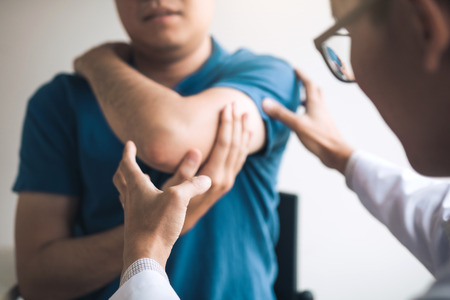Introduction to Hip Fractures in the Elderly
Hip fractures represent a significant health concern for older adults in the United Kingdom, with incidence rates steadily rising as the population ages. Each year, over 70,000 hip fractures are reported among people aged 65 and above, making it one of the most common serious injuries in this age group. The primary causes include falls—often related to age-associated frailty, reduced bone density such as osteoporosis, and chronic medical conditions that affect balance and mobility. In addition to the immediate physical trauma, hip fractures frequently lead to a decline in independence and overall quality of life for elderly individuals. The consequences extend beyond physical health, impacting mental wellbeing and placing emotional and practical demands on families and carers. The unique needs of older adults recovering from hip fractures require a comprehensive approach that addresses not only the physical injury but also holistic rehabilitation and ongoing support. Within the UK’s healthcare context, tailored physiotherapy interventions play a pivotal role in promoting recovery, restoring mobility, and supporting elderly patients as they navigate the challenges of regaining their confidence and independence after such a life-altering event.
2. Role of Physiotherapy in Recovery
Physiotherapy is a cornerstone in the journey towards recovery for elderly patients following a hip fracture. In the UK, physiotherapists not only address the physical aspects of rehabilitation but also take into account the emotional wellbeing of older adults. This holistic approach is particularly crucial, as elderly individuals often face unique challenges such as frailty, reduced mobility, and heightened anxiety after a significant injury.
Physical Healing: Restoring Mobility and Independence
The primary goal of physiotherapy is to restore movement and function. After surgery or initial treatment, tailored exercise programmes help to improve strength, flexibility, balance, and coordination. Early mobilisation—often within 24 to 48 hours post-operation—is encouraged within NHS trusts across the UK to reduce complications such as pressure sores or chest infections. Below is an overview of typical physiotherapy interventions:
| Intervention | Description | Benefits |
|---|---|---|
| Mobilisation Exercises | Gentle guided movements to gradually increase activity levels | Reduces risk of muscle wasting and enhances confidence in movement |
| Strengthening Programmes | Targeted exercises for lower limb muscles and core stability | Aids in regaining independence for daily activities |
| Balance Training | Activities designed to improve stability and prevent falls | Lowers risk of future fractures and boosts self-assurance |
| Pain Management Techniques | Manual therapy, positioning advice, and education on pain relief strategies | Makes movement more comfortable and encourages participation in rehab |
Emotional Wellbeing: Gentle Support and Encouragement
The impact of a hip fracture can extend beyond the physical injury, often affecting an individual’s mood, confidence, and sense of independence. Recognising this, UK-based physiotherapists offer compassionate support throughout the recovery process. They listen actively to patients’ concerns, set achievable goals together, and celebrate small victories—fostering hope and reassurance.
Strategies for Emotional Support Include:
- Patient-Centred Goal Setting: Collaborating with patients to establish meaningful milestones that matter to them personally.
- Education and Empowerment: Providing clear information about the recovery process so individuals feel informed and involved in their care decisions.
- Family Involvement: Encouraging loved ones to participate in therapy sessions where appropriate, strengthening social connections and reducing isolation.
- Referral to Additional Resources: When needed, signposting to local support groups or psychological services available through the NHS or community organisations.
Together Towards Recovery
The role of physiotherapy in hip fracture recovery is both practical and deeply supportive. By combining expert physical rehabilitation with a gentle, person-centred approach, UK physiotherapists help older adults regain not only their mobility but also their confidence and sense of dignity—enabling them to return home safely and enjoy a better quality of life.

3. Assessment and Personalised Care Planning
In the UK, a comprehensive and holistic approach to assessment is fundamental in physiotherapy interventions for elderly hip fracture patients. Upon admission, physiotherapists undertake a thorough evaluation encompassing not only physical capabilities such as mobility, muscle strength, balance, and pain levels, but also cognitive status, emotional wellbeing, and any pre-existing medical conditions. This careful assessment is crucial for understanding each patient’s unique circumstances and identifying potential risks or barriers to recovery.
Following this initial assessment, individualised goal setting becomes central to the care plan. In line with best practices across the NHS, physiotherapists work collaboratively with patients and their families to identify personal goals that are both meaningful and achievable—whether that’s regaining independence in daily activities, improving walking ability, or simply returning safely home. These goals are regularly reviewed and adapted throughout the rehabilitation process to reflect progress and changing needs.
Collaboration is another cornerstone of best practice in the UK. Physiotherapists routinely liaise with multidisciplinary teams—including occupational therapists, nurses, geriatricians, social workers, and sometimes community support services—to ensure that care is truly tailored and coordinated. This team-based approach helps address not only the physical aspects of recovery but also broader factors such as home safety, social support networks, and emotional resilience. By prioritising personalised care planning and interdisciplinary teamwork, UK physiotherapists strive to maximise each patient’s potential for recovery while upholding dignity and promoting long-term wellbeing.
4. Evidence-based Physiotherapy Interventions
Delivering effective physiotherapy interventions for elderly hip fracture patients requires an evidence-based approach that aligns with best practices across the UK. The goal is to maximise recovery, restore independence, and prevent future complications, all while recognising the unique needs of older adults.
Early Mobilisation
Current NHS guidelines strongly advocate for early mobilisation — ideally within 24 hours post-surgery — as it is associated with improved outcomes and reduced hospital stay. Early movement helps maintain muscle strength, minimises the risk of pressure sores, and supports psychological wellbeing.
Strengthening Exercises
Targeted strengthening exercises are central to rehabilitation. These exercises focus on major lower limb muscle groups, particularly the quadriceps, gluteals, and calf muscles. Gradual resistance training can be introduced according to each individual’s tolerance and progress.
Balance Training
Many elderly hip fracture patients experience balance deficits that increase their risk of falls. Physiotherapists employ tailored balance retraining, which may include supported standing activities, static and dynamic balance tasks, and functional movement practice.
Summary of Core Interventions
| Intervention | Purpose | UK Best Practice Example |
|---|---|---|
| Early Mobilisation | Restore movement and reduce complications | Supported sitting and assisted walking within 24 hours post-op |
| Strengthening Exercises | Improve muscle power for mobility and transfers | Seated knee extensions, bridging exercises, ankle pumps |
| Balance Training | Enhance stability and reduce falls risk | Tandem standing, weight shifts, step-ups with support |
| Pain Management Strategies | Enable active participation in rehabilitation | Use of analgesia protocols, gentle manual therapy, guided relaxation techniques |
Pain Management Strategies
Adequate pain control is fundamental for enabling early movement and engagement in therapy. This often involves multidisciplinary collaboration to provide appropriate analgesics alongside non-pharmacological methods such as heat/cold packs or gentle manual techniques. Regular pain assessment ensures interventions remain person-centred and responsive to changing needs.
Cultural Sensitivity in Care Delivery
The UK’s best practice approach is underpinned by a commitment to compassionate care — listening carefully to patient preferences, involving family where appropriate, and adapting interventions for cultural beliefs or language needs. By embracing this holistic ethos, physiotherapists foster trust and encourage a positive rehabilitation journey for every elderly hip fracture patient.
5. Supporting Independence and Preventing Future Falls
Regaining independence after a hip fracture is an essential part of the recovery journey for elderly patients in the UK. Physiotherapists play a pivotal role in empowering patients to rebuild confidence and maintain safety, both at home and within community settings. Here are some practical recommendations tailored to the British context.
Promoting Safe Mobility
Encouraging gradual, supervised mobility is key. Physiotherapists often recommend starting with supported walking using aids such as Zimmer frames or walking sticks, progressing to unaided movement as strength and balance improve. Home visits and community-based rehabilitation services, widely available through the NHS, provide continued support and ensure a safe environment for mobility practice.
Personalised Exercise Programmes
Bespoke exercise plans focusing on lower limb strength, balance, and flexibility are vital. Simple routines—such as sit-to-stand exercises from an armchair or gentle heel raises at the kitchen counter—can be practised daily. Involvement in local falls prevention classes or Steady On Your Feet groups, commonly offered by UK councils, further enhances strength and social engagement.
Home Safety Assessments
Physiotherapists often collaborate with occupational therapists to assess homes for hazards. Recommendations might include removing loose rugs, installing grab rails in bathrooms, ensuring good lighting, and encouraging the use of sturdy footwear. These small adaptations can make a significant difference in preventing future accidents.
Supporting the Transition Back Home
A smooth transition from hospital to home or supported living is crucial. Discharge planning should involve carers and family members, offering clear guidance on safe transfer techniques and proper use of mobility aids. Utilising local resources such as Age UK’s support services can ease this transition and reduce feelings of isolation.
Encouraging Social Participation
Remaining socially active helps to boost morale and prevent deconditioning. Patients are encouraged to participate in community activities or attend local day centres where gentle group exercises are facilitated under professional supervision. This approach not only aids physical recovery but also nurtures emotional well-being.
Ongoing Education and Support
Education about fall prevention strategies—such as regular vision checks, medication reviews with GPs, and maintaining hydration—is provided throughout rehabilitation. Continued access to physiotherapy advice via telephone helplines or follow-up clinics ensures ongoing reassurance for both patients and their families as they adjust to life post-fracture.
6. Collaborative Care and Family Involvement
In the UK, the journey to recovery for elderly hip fracture patients is seldom a solitary one. Multidisciplinary teamwork is at the very heart of best practice, ensuring that every aspect of a patient’s well-being is considered and addressed. This collaborative approach unites physiotherapists, occupational therapists, nurses, doctors, social workers, and other healthcare professionals in creating a tailored rehabilitation plan. Each team member contributes their unique expertise, allowing for more comprehensive assessments and interventions that support both physical recovery and emotional resilience.
The Role of Families in Rehabilitation
Families play a crucial role in the success of rehabilitation after a hip fracture. Involving family members from the earliest stages not only fosters a supportive environment but also empowers them to assist with ongoing care once the patient returns home. In British practice, families are often invited to attend therapy sessions, receive education about safe mobility techniques, and participate in discharge planning meetings. This inclusive approach helps loved ones feel confident in providing day-to-day support and encourages patients to stay motivated throughout their recovery.
Effective Communication Across Teams
Clear and compassionate communication between healthcare teams and families is vital for holistic care. Regular updates ensure that everyone remains informed about progress, setbacks, or changes in treatment plans. By prioritising open dialogue, physiotherapists can address concerns promptly and adjust interventions as needed, always keeping the patient’s comfort and dignity at the forefront.
A Compassionate Community Approach
Ultimately, collaborative care extends beyond hospital walls. Community-based resources such as local falls clinics, home adaptations services, and voluntary organisations provide ongoing support during the transition back to daily life. When multidisciplinary professionals work hand-in-hand with families and community networks, elderly patients are given every opportunity to regain independence with confidence and compassion—a hallmark of quality care across the UK.
7. Conclusion and Future Directions
In summary, physiotherapy interventions remain a cornerstone of the rehabilitation journey for elderly hip fracture patients in the UK. As highlighted, early mobilisation, tailored exercise programmes, multidisciplinary collaboration, and community-based follow-up are all considered best practices that contribute to improved outcomes and quality of life for older adults recovering from hip fractures. Equally important is the need for compassionate, individualised care that respects each patient’s unique circumstances and aspirations.
Ongoing developments in the field include technological advancements such as tele-rehabilitation and digital monitoring tools, which are gradually being integrated into NHS practice to enhance accessibility and continuity of care. Furthermore, there is an increasing focus on preventive strategies, including frailty screening and falls prevention programmes, aiming to address risk factors before a fracture occurs. As the population ages and demand on healthcare services grows, the sector faces challenges related to workforce capacity, equitable access to high-quality rehabilitation, and adapting services for those with complex co-morbidities.
Looking ahead, continued research, investment in workforce training, and ongoing policy support will be vital in overcoming these challenges. By embracing innovation while maintaining the core values of empathy and person-centred care, physiotherapists across the UK can continue to empower elderly hip fracture patients towards greater independence and wellbeing.


